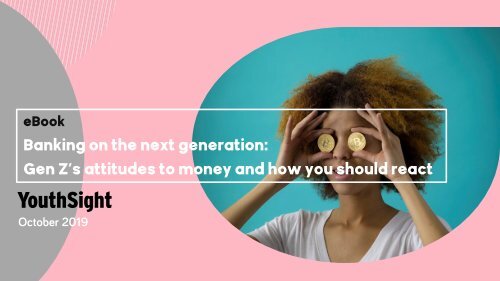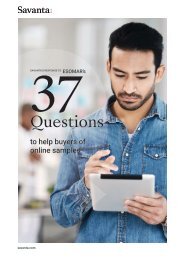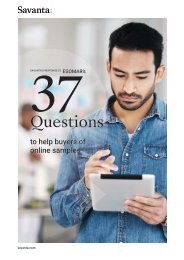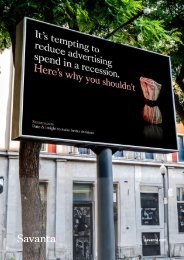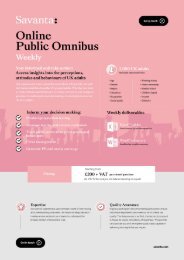YouthSight eBook - Banking on the next generation
Gen Z's attitudes to money and how you should react
Gen Z's attitudes to money and how you should react
Create successful ePaper yourself
Turn your PDF publications into a flip-book with our unique Google optimized e-Paper software.
<str<strong>on</strong>g>eBook</str<strong>on</strong>g><br />
<str<strong>on</strong>g>Banking</str<strong>on</strong>g> <strong>on</strong> <strong>the</strong> <strong>next</strong> generati<strong>on</strong>:<br />
Gen Z’s attitudes to m<strong>on</strong>ey and how you should react<br />
October 2019
The <str<strong>on</strong>g>YouthSight</str<strong>on</strong>g> Take<br />
Our clients frequently ask us how <strong>the</strong> future generati<strong>on</strong> of<br />
c<strong>on</strong>sumers are currently using and managing <strong>the</strong>ir m<strong>on</strong>ey, and<br />
what this will look like in <strong>the</strong> future.<br />
Through this <str<strong>on</strong>g>eBook</str<strong>on</strong>g> we uncover how Gen Z – <strong>the</strong> generati<strong>on</strong> of<br />
young people born from 1995 <strong>on</strong>wards – are actually smarter<br />
and savvier with <strong>the</strong>ir m<strong>on</strong>ey than <strong>the</strong>y are often given credit<br />
for.<br />
They want to access <strong>the</strong>ir m<strong>on</strong>ey digitally and informally,<br />
which a new breed of cutting-edge businesses understand.<br />
M<strong>on</strong>ey must integrate seamlessly into young people’s lives and<br />
speak <strong>the</strong>ir language.<br />
Getting this right can be challenging. To keep up-to-date <strong>on</strong><br />
<strong>the</strong> evolving attitudes and preferences of your youth audience,<br />
get in touch to see how our State of <strong>the</strong> Youth Nati<strong>on</strong> tracker<br />
can help.
In this <str<strong>on</strong>g>eBook</str<strong>on</strong>g> we<br />
will explore…<br />
1<br />
Gen Z’s cautious attitude towards m<strong>on</strong>ey<br />
What are <strong>the</strong>ir saving habits?<br />
How much m<strong>on</strong>ey do <strong>the</strong>y really have?<br />
What do <strong>the</strong>y spend <strong>the</strong>ir m<strong>on</strong>ey <strong>on</strong>?<br />
2<br />
3<br />
How m<strong>on</strong>ey seamlessly integrates with<br />
young people’s lives<br />
The young and <strong>the</strong> cashless<br />
Why is digital banking so appealing to<br />
Gen Z?<br />
How you can align with young people’s<br />
evolving attitudes to m<strong>on</strong>ey<br />
How can your brand react to Gen Z’s<br />
changing financial behaviours and<br />
attitudes?
1<br />
Gen Z’s cautious<br />
attitude towards m<strong>on</strong>ey<br />
4
Gen Z in <strong>the</strong> UK are living in a time of uncertainty<br />
With <strong>the</strong> UK due to leave <strong>the</strong> EU and <strong>the</strong> future becoming much more uncertain for Gen Z, <strong>the</strong> backdrop to <strong>the</strong>ir lives is<br />
<strong>on</strong>e of political, social and financial instability.<br />
Gen Z grew up in <strong>the</strong> post 2008 crash period – a time of austerity and less-than-optimistic prospects for <strong>the</strong> future.<br />
More recently, <strong>the</strong> housing crisis and worries over job prospects have increased uncertainty about <strong>the</strong>ir future and<br />
specifically <strong>the</strong>ir finances.<br />
69%<br />
feel <strong>the</strong>ir future prospects will change for<br />
<strong>the</strong> worse by leaving <strong>the</strong> EU<br />
65%<br />
of Gen Z are worried about committing to<br />
any major financial decisi<strong>on</strong>s at this point<br />
5<br />
Source: <str<strong>on</strong>g>YouthSight</str<strong>on</strong>g> State of <strong>the</strong> Youth Nati<strong>on</strong> Y1.5 Feb 2019 (N=1028), A_Y20_3 December 2018 (N=1030)
This uncertainty is reflected in <strong>the</strong>ir surprisingly n<strong>on</strong>frivolous<br />
attitude towards m<strong>on</strong>ey<br />
60% of 16-24s disagree<br />
that <strong>the</strong>y tend to spend<br />
m<strong>on</strong>ey without thinking<br />
64%<br />
Have some form<br />
of savings<br />
61% of 16-24s would be<br />
unhappy to have short term<br />
debt to allow <strong>the</strong>m to buy<br />
<strong>the</strong> things <strong>the</strong>y want<br />
60% of 16-24s feel<br />
that <strong>the</strong>y are <strong>on</strong> top<br />
of <strong>the</strong>ir finances<br />
6<br />
Source: <str<strong>on</strong>g>YouthSight</str<strong>on</strong>g> State of <strong>the</strong> Youth Nati<strong>on</strong> Y34.2, Y42_2, Y26.1. Feb 2019 (N=1028), A_Y35 Jan 2018 (1053)
L<strong>on</strong>g term goals mostly drive Gen Z to save m<strong>on</strong>ey<br />
35% of Gen Z plan to start saving<br />
for retirement in <strong>the</strong>ir 20s. 12% of<br />
<strong>the</strong>m are already saving.<br />
52% of prospective Gen Z home<br />
buyers are already saving for a<br />
house.<br />
59% of Gen Z want to buy a<br />
home within <strong>the</strong> <strong>next</strong> 5 years.<br />
7<br />
Source: Bank of America, The Homebuyer Insights Report, The Center for Generati<strong>on</strong>al Kinetics
However, sometimes spending<br />
m<strong>on</strong>ey <strong>on</strong> status symbols take<br />
priority<br />
65% of Gen Z ranked travel as<br />
<strong>the</strong> most important way that<br />
<strong>the</strong>y spend <strong>the</strong>ir m<strong>on</strong>ey.<br />
26% are saving for a new ph<strong>on</strong>e<br />
or electr<strong>on</strong>ic device.<br />
17% are saving for <strong>the</strong>ir own cars.<br />
8<br />
Source: HAS Store, Booking.com<br />
8
What young people are spending <strong>the</strong>ir m<strong>on</strong>ey <strong>on</strong>…<br />
FOOD EXPERIENCES FASHION<br />
Three-quarters of 16-24’s spend m<strong>on</strong>ey<br />
<strong>on</strong> eating out every m<strong>on</strong>th – Gen Z love<br />
catching up with <strong>the</strong>ir friends over a<br />
meal.<br />
Bey<strong>on</strong>d documenting <strong>the</strong>ir aes<strong>the</strong>tic food<br />
adventures <strong>on</strong> Instagram, this tech-savvy<br />
generati<strong>on</strong> are inspiring innovative food<br />
delivery platforms like JustEat and<br />
UberEats.<br />
They are also driving <strong>the</strong> increase in<br />
alternative food opti<strong>on</strong>s such as <strong>the</strong> rise<br />
of meat and dairy alternatives – all of<br />
which is challenging <strong>the</strong> current culinary<br />
landscape.<br />
Gen Z have a reputati<strong>on</strong> of being sensible,<br />
but <strong>the</strong>y are more discerning when it comes<br />
to experiences <strong>the</strong>y have. They demand<br />
more – experiences need to be unique<br />
enough for <strong>the</strong>m to share with o<strong>the</strong>rs <strong>on</strong><br />
social media.<br />
67% of 16-24s would choose an experience<br />
over a physical gift - young people get more<br />
value out of making memories – both real<br />
and digital – than accumulating ‘stuff.’<br />
We see this in <strong>the</strong> unstoppable rise of<br />
festivals, pop-up shops and branded<br />
experiences that young people are keen to<br />
get involved in. If you are not already doing<br />
experiential marketing, it’s time to start!<br />
The <strong>on</strong>ly outlier from this tendency to<br />
spend time with o<strong>the</strong>rs in outdoor<br />
experiences is fashi<strong>on</strong> – Gen Z use fashi<strong>on</strong><br />
as a form of self-expressi<strong>on</strong>.<br />
As of June 2019, 59% of Gen Z spent <strong>the</strong>ir<br />
m<strong>on</strong>ey <strong>on</strong> clo<strong>the</strong>s/shoes in <strong>the</strong> last m<strong>on</strong>th,<br />
which is unsurprising as clothing is central<br />
to how young people present <strong>the</strong>mselves.<br />
Despite <strong>the</strong> popularity of fast fashi<strong>on</strong>, <strong>the</strong>y<br />
are also c<strong>on</strong>scious of <strong>the</strong> ethical impact of<br />
fast fashi<strong>on</strong>. Ethics are an influencing factor,<br />
however price and c<strong>on</strong>venience is more<br />
important when it comes to spending <strong>on</strong><br />
fashi<strong>on</strong>.<br />
9<br />
Source: <str<strong>on</strong>g>YouthSight</str<strong>on</strong>g> State of <strong>the</strong> Youth Nati<strong>on</strong> C2 June 2019 (N=1034), Y48 Feb 2019 (N=1028)
Why should you care what young people spend <strong>the</strong>ir m<strong>on</strong>ey <strong>on</strong>?<br />
It’s easy to think that young people d<strong>on</strong>’t want to spend <strong>the</strong>ir m<strong>on</strong>ey <strong>on</strong> big purchases<br />
such as a house or car because it takes too l<strong>on</strong>g...<br />
…However instant gratificati<strong>on</strong> isn’t <strong>the</strong> reas<strong>on</strong> why young people are spending <strong>on</strong><br />
smaller, easy access items…<br />
Mini status symbols deliver cultural currency and are obtainable<br />
Status is being redefined by young people – for older generati<strong>on</strong>s having a big house<br />
and a luxury car symbolise status, however because young people can’t afford <strong>the</strong>se<br />
things, <strong>the</strong>y turn to mini status symbols instead.<br />
These are things like going to quirky food places, festivals, branded experiences or<br />
keeping up with <strong>the</strong> latest fashi<strong>on</strong>. Status for young people is far less extravagant.<br />
10
2<br />
The young and <strong>the</strong> cashless
41% of Gen Z say <strong>the</strong>y<br />
rarely use cash and a third<br />
agree that traditi<strong>on</strong>al<br />
wallets will so<strong>on</strong> become<br />
obsolete in 10 years’ time<br />
Source: Manole Capital's sec<strong>on</strong>d annual Gen Z Survey
Gen Z are savvy with where <strong>the</strong>y<br />
spend <strong>the</strong>ir m<strong>on</strong>ey – but how do<br />
<strong>the</strong>y access it?<br />
Gen Z are rejecting traditi<strong>on</strong>al m<strong>on</strong>ey<br />
management for refreshing digital alternatives<br />
We’re living in an increasingly cashless society – where c<strong>on</strong>tactless payments mean that<br />
m<strong>on</strong>ey is digital, ra<strong>the</strong>r than physical.<br />
Services like PayPal and Apple Pay allow young people to spend digitally and feel<br />
secure in doing so – more recently not-for-profit organisati<strong>on</strong>s such as The Big Issue<br />
have even g<strong>on</strong>e cashless al<strong>on</strong>g with charities such as Oxfam, Barnardos and NCSPCC.<br />
70%<br />
of Gen Z have made in-app payments in <strong>the</strong> past year,<br />
whe<strong>the</strong>r it be <strong>on</strong> a payment app such as Google Pay or Apple<br />
Pay or <strong>on</strong> a retailer’s app, more than any o<strong>the</strong>r generati<strong>on</strong><br />
23%<br />
of Gen Z predicts physical cards will so<strong>on</strong> be obsolete as<br />
opposed to just 6% of <strong>the</strong> over 55s.<br />
Source: U.S Mobile App Report 2017
Young people are blaming cashless<br />
payments as <strong>the</strong>y end up spending more<br />
<strong>on</strong> nights out and at festivals than <strong>the</strong>y<br />
had planned. This suggests that <strong>the</strong> lack<br />
of physical cash makes it hard for Gen Z<br />
to keep track of spending. In fact, 1 in 5<br />
say having cash <strong>on</strong> <strong>the</strong>m makes <strong>the</strong>m<br />
spend less m<strong>on</strong>ey.<br />
But <strong>the</strong> slow decline of physical<br />
m<strong>on</strong>ey doesn’t mean that young people<br />
can’t budget. A wave of new banking<br />
apps are challenging <strong>the</strong> traditi<strong>on</strong>al<br />
financial landscape to help Gen Z better<br />
manage <strong>the</strong>ir m<strong>on</strong>ey <strong>on</strong> a daily basis…<br />
14<br />
Source: <str<strong>on</strong>g>YouthSight</str<strong>on</strong>g> x Link (2016) (N=492)
Source: Finder<br />
Digital banks are fun, practical<br />
alternatives to traditi<strong>on</strong>al high-street<br />
banks<br />
Digital banks particularly appeal to Gen Z - making paying,<br />
transferring and saving m<strong>on</strong>ey effortless…<br />
C<strong>on</strong>venience<br />
Seamlessness<br />
Some digital banks offer free foreign<br />
exchange payments, which is ideal for a<br />
generati<strong>on</strong> that loves to travel. They also<br />
allow requesting m<strong>on</strong>ey at a few taps of<br />
your finger – perfect for when Gen Z<br />
want to split <strong>the</strong> bill.<br />
More recently, M<strong>on</strong>zo have announced<br />
its latest innovati<strong>on</strong> enabling you to get<br />
paid a day early so now Gen Z can spend<br />
<strong>on</strong> those experiences <strong>the</strong>y crave without<br />
having to wait until payday!<br />
They are seamlessly integrating<br />
<strong>the</strong>mselves into Gen Z’s lives, notifying<br />
<strong>the</strong>m immediately when a payment<br />
enters or leaves <strong>the</strong>ir account, informing<br />
<strong>the</strong>m when, where and how <strong>the</strong>y’re<br />
spending and allowing <strong>the</strong>m to save<br />
m<strong>on</strong>ey in multiple ‘pots’ for different<br />
goals – like a trip away or a new ph<strong>on</strong>e.<br />
Two-thirds of banking customers say <strong>the</strong>y plan to c<strong>on</strong>vert fully to<br />
digital banking in <strong>the</strong> future (rejecting high street banks).<br />
M<strong>on</strong>zo has<br />
even released<br />
a feature<br />
where you can<br />
automatically<br />
save £2 every<br />
time <strong>the</strong><br />
temperature<br />
where you are<br />
goes above 20<br />
degrees
Making m<strong>on</strong>ey management easy<br />
More and more apps are emerging from <strong>the</strong> fintech industry designed to<br />
seamlessly integrate <strong>the</strong>ir financial expertise into <strong>the</strong> lives of young<br />
people. So, what are <strong>the</strong> functi<strong>on</strong>s of <strong>the</strong>se apps and how do <strong>the</strong>y help?<br />
AI Bots<br />
AI Bots are helping young people to save by setting saving targets, putting m<strong>on</strong>ey aside<br />
automatically, and even chasing up friends that owe m<strong>on</strong>ey. They are making financial<br />
management easily accessible to Gen Z, seamlessly fitting into <strong>the</strong>ir everyday lives via<br />
<strong>the</strong>ir smartph<strong>on</strong>es. Apps like Cleo can let you know whe<strong>the</strong>r you can afford that<br />
takeaway t<strong>on</strong>ight.<br />
Young people are changing <strong>the</strong><br />
way we invest. Most of our<br />
customers are under 40 years<br />
old and <strong>the</strong>y’ve been telling us<br />
<strong>the</strong>y want a socially resp<strong>on</strong>sible<br />
investment opti<strong>on</strong> for some<br />
time.<br />
Ben Stanway, co-founder of<br />
M<strong>on</strong>eybox<br />
Investing<br />
Gen Z can be intimidated by <strong>the</strong> idea of<br />
investing. By rounding up your everyday<br />
purchases to <strong>the</strong> nearest £ and investing <strong>the</strong><br />
difference, apps such as M<strong>on</strong>eybox and Acorns<br />
are making investment effortless – and ethical.
There is a stereotype that cryptocurrency like Bitcoin are<br />
<strong>the</strong> way forward for Gen Z – in reality <strong>the</strong>y are too riskaverse<br />
to invest in it.<br />
70%<br />
of Gen Z’s are unlikely to buy<br />
cryptocurrency in <strong>the</strong> <strong>next</strong> 6 m<strong>on</strong>ths<br />
37%<br />
of young people d<strong>on</strong>’t yet trust<br />
cryptocurrencies such as Bitcoin<br />
14%<br />
of Millennial and Gen Z participants cited a<br />
“lack of understanding” as <strong>the</strong>ir main<br />
reas<strong>on</strong> for not getting involved with crypto<br />
Gen Z will have to work very hard to attain<br />
ec<strong>on</strong>omic security, and <strong>the</strong>y’re not willing to risk<br />
<strong>the</strong>ir funds to invest in crypto. M<strong>on</strong>ey still needs to<br />
feel real and safe – something crypto just doesn’t<br />
offer to this generati<strong>on</strong> yet.<br />
Source: Business Insider, Decrypt<br />
Facebook’s new and c<strong>on</strong>troversial cryptocurrency - Libra<br />
Facebook could put a crypto wallet in <strong>the</strong> pers<strong>on</strong>al accounts<br />
of billi<strong>on</strong>s of people around <strong>the</strong> world, making m<strong>on</strong>ey<br />
transfers as easy as sending a message or a photograph<br />
today. Gen Z spend <strong>the</strong> majority of <strong>the</strong>ir time <strong>on</strong>line doing<br />
just this, which may make crypto more accessible to Gen Z<br />
and change <strong>the</strong> way <strong>the</strong>y perceive crypto.
How can you emulate <strong>the</strong> successes of <strong>the</strong> new wave<br />
of digital banks?<br />
Digital m<strong>on</strong>ey systems engage with Gen Z differently…<br />
1<br />
2<br />
3<br />
They engage with <strong>the</strong> user just as if an advisor in a bank would, and can<br />
even provide helpful feedback <strong>on</strong> spending.<br />
They are informal – m<strong>on</strong>ey is a stressful subject for young people, so it’s<br />
essential to speak in a familiar language.<br />
They are pers<strong>on</strong>al– for older generati<strong>on</strong>s <strong>the</strong> wallet is a pers<strong>on</strong>al space,<br />
however for young people, <strong>the</strong>ir ph<strong>on</strong>es are <strong>the</strong>ir pers<strong>on</strong>al space – and<br />
this is where digital m<strong>on</strong>ey system are<br />
18
3<br />
How to align with Gen Z’s evolving<br />
attitudes to m<strong>on</strong>ey
Source: <str<strong>on</strong>g>YouthSight</str<strong>on</strong>g> (May 2019)<br />
Help young people out by acknowledging<br />
when <strong>the</strong>y decide to spend <strong>the</strong>ir hard-earned<br />
m<strong>on</strong>ey with you.<br />
Offer <strong>the</strong>m little extras (rewards) al<strong>on</strong>g <strong>the</strong><br />
way that are…<br />
Flexible<br />
01 02<br />
Relevant<br />
Little and often<br />
03 04<br />
Seamless<br />
N<strong>on</strong>-m<strong>on</strong>etary!<br />
05 Advocative<br />
06<br />
If I'm buying things often from <strong>the</strong> same<br />
place, I'd like to be rewarded for being loyal.<br />
13-15 year old
Taking a <strong>on</strong>e-size-fits-all approach to rewards is<br />
unlikely to be successful<br />
Young people have flexibility in many o<strong>the</strong>r aspects of <strong>the</strong>ir lives,<br />
and <strong>the</strong> way <strong>the</strong>y spend <strong>the</strong>ir m<strong>on</strong>ey should be no excepti<strong>on</strong>.<br />
01 Flexible<br />
Take Sephora for example, who<br />
offer a range of different opti<strong>on</strong>s for<br />
how customers can use <strong>the</strong>ir points.<br />
Sephora offers customers more<br />
than just a transacti<strong>on</strong>al rewards<br />
program – you d<strong>on</strong>’t just get to use<br />
points <strong>on</strong> products, you can also<br />
develop your beauty skills! Instore<br />
beauty services such as free beauty<br />
classes are part of <strong>the</strong>ir loyalty<br />
programme aside from actual<br />
products.
Provide Gen Z with offers and rewards that are<br />
relevant to <strong>the</strong>m<br />
Getting this right can feel a bit hit or miss, so brands should keep up-to-date with <strong>the</strong><br />
evolving attitudes and preferences of 16-24s.<br />
02 Relevant<br />
VOXI Drop<br />
VOXI, Vodaf<strong>on</strong>e’s mobile network aimed at under 30’s, has announced a new<br />
rewards programme that encompasses both relevance and regularity.<br />
It gives customers exclusive freebies and offers every m<strong>on</strong>th. Freebies and offers will be<br />
available <strong>on</strong> things that matter to young people - food, fashi<strong>on</strong>, music, entertainment and<br />
festivals.<br />
The first VOXI Drop is a free Time Out More card, which would usually cost you £29.99 –<br />
appealing for Gen Z who are always <strong>on</strong> <strong>the</strong> look out for new experiences.
Gen Z aren’t spending <strong>on</strong> big flashy items and<br />
<strong>the</strong>refore d<strong>on</strong>’t expect extravagant rewards - a<br />
little goes a l<strong>on</strong>g way!<br />
03 Little and<br />
often<br />
Superdrug’s loyalty card lets customers spend as little as 100<br />
points, which is £1, <strong>on</strong> <strong>the</strong>ir purchase at <strong>the</strong> till. £1 off may not<br />
sound like an exciting rewards, but to Gen Z who are m<strong>on</strong>eyc<strong>on</strong>scious,<br />
a little goes a l<strong>on</strong>g way.<br />
Customers can even pay partly with points and partly with cash<br />
- this means <strong>the</strong>y d<strong>on</strong>’t have to wait too l<strong>on</strong>g before <strong>the</strong>y start<br />
seeing <strong>the</strong> savings.<br />
66%<br />
Of <strong>the</strong> 13-15yr olds we surveyed would prefer regular, smaller offers<br />
compared to less frequent, bigger offers.<br />
Source: <str<strong>on</strong>g>YouthSight</str<strong>on</strong>g> (May 2019)
Gen Z have busy lives –<br />
make it easy for <strong>the</strong>m to remain loyal<br />
04 Seamless<br />
Starbucks has <strong>the</strong> most regularly used loyalty<br />
rewards app (48%) am<strong>on</strong>g a list of major<br />
restaurant chains. Why is <strong>the</strong> app so popular?<br />
The answer is seamless digital integrati<strong>on</strong>.<br />
In order to earn loyalty points (or stars, in <strong>the</strong>ir<br />
case), customers must order or pay with <strong>the</strong><br />
Starbucks app – something that is very familiar<br />
to Gen Z and part of <strong>the</strong>ir every day lives.<br />
This makes claiming and using rewards an<br />
automatic, seamless process.<br />
Source: The Manifest
Reward doesn’t have to be m<strong>on</strong>etary. Can you<br />
align to Gen Z’s values and encourage <strong>the</strong>m to<br />
pass <strong>the</strong> reward <strong>on</strong> instead?<br />
05<br />
N<strong>on</strong>m<strong>on</strong>etary<br />
Gen Z are a very passi<strong>on</strong>ate and aware generati<strong>on</strong> – <strong>the</strong>y have many c<strong>on</strong>cerns about <strong>the</strong> future of <strong>the</strong> world with<br />
<strong>the</strong> most important political issue being <strong>the</strong> envir<strong>on</strong>ment stated by 49%, as well as healthcare – particularly<br />
mental health – and equality.<br />
Toms are a shoe brand,<br />
renowned for its One for<br />
One approach, in which <strong>the</strong><br />
brand d<strong>on</strong>ates a pair of<br />
shoes to a child in need for<br />
each pair of shoes<br />
purchased.<br />
WEEWOOD, a watch brand, understands Gen Z’s c<strong>on</strong>cerns about<br />
<strong>the</strong> future of <strong>the</strong> planet.<br />
They plant a tree for every watch<br />
purchased and have planted<br />
442.246 trees across <strong>the</strong> globe so<br />
far since <strong>the</strong> programme began in<br />
2010.<br />
As a result, spending <strong>on</strong> fashi<strong>on</strong> – a seemingly unethical act – rewards Gen Z by making <strong>the</strong>m feel like <strong>the</strong>y are doing good for<br />
<strong>the</strong> world.<br />
Source: <str<strong>on</strong>g>YouthSight</str<strong>on</strong>g> State of <strong>the</strong> Youth Nati<strong>on</strong> A_H10 June 2019 (N=1034)
06<br />
Unique!<br />
Advocative<br />
Can you reward Gen Z<br />
for advocating your<br />
brand?<br />
Gen Z are highly digitally c<strong>on</strong>nected, spending most of <strong>the</strong>ir<br />
time <strong>on</strong>line <strong>on</strong> social media. Therefore, rewarding Gen Z when<br />
<strong>the</strong>y share your brand is a win-win – <strong>the</strong>y save m<strong>on</strong>ey and your<br />
brand reaches a wide network of people.<br />
Some examples of brands using advocacy as a form of reward<br />
are…<br />
Bulb are a renewable energy brand that will give you and<br />
your friend £50 each, to say thanks when <strong>the</strong>y join through<br />
your referral link.<br />
73%<br />
of Gen Z’s spend <strong>the</strong><br />
majority of <strong>the</strong>ir time<br />
<strong>on</strong>line <strong>on</strong> social media.<br />
Airbnb rewards you with m<strong>on</strong>ey off when you invite your<br />
friends to Airbnb via email or by sharing your invite link <strong>on</strong><br />
social media - Gen Z love to travel!<br />
Uber lets you earn free rides by inviting friends to sign up<br />
and ride with Uber using your pers<strong>on</strong>al code, making life<br />
even more c<strong>on</strong>venient for this zero-effort generati<strong>on</strong>.<br />
26<br />
Source: <str<strong>on</strong>g>YouthSight</str<strong>on</strong>g> State of <strong>the</strong> Youth Nati<strong>on</strong> A_W61 June 2018 (N=1037)
Showing you understand Gen Z’s<br />
values and attitudes towards m<strong>on</strong>ey<br />
is certainly likely to result in repeat<br />
purchase.<br />
However, repeat purchase is not <strong>the</strong><br />
same as loyalty – Gen Z are savvy<br />
enough to find cheaper alternatives.<br />
If it’s brand loyalty that you<br />
want to build, you need Gen Z<br />
to love your brand. You can find<br />
<str<strong>on</strong>g>YouthSight</str<strong>on</strong>g>’s take <strong>on</strong> brand love<br />
and how to cultivate it here.
Many of <strong>the</strong> data points in this<br />
<str<strong>on</strong>g>eBook</str<strong>on</strong>g> come from our youth<br />
insight tracker:<br />
State of <strong>the</strong> Youth Nati<strong>on</strong><br />
tracks 1000s of questi<strong>on</strong>s so<br />
our clients d<strong>on</strong>’t have to<br />
Engage<br />
Gen Z<br />
Inspire<br />
Gen Z<br />
Grow<br />
Brand Love<br />
Get in touch for a demo to see how State of <strong>the</strong> Youth Nati<strong>on</strong><br />
can future-proof your organisati<strong>on</strong>: research@youthsight.com


